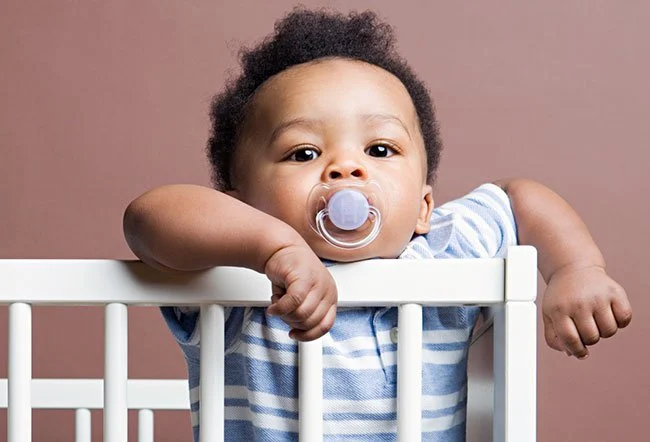Pacifiers Can Be Harmful For Your Baby: Child Health Expert Recommends Ways Of Pacifying A Child Without The Use Of Pacifiers

Your baby’s loud cries can sometimes be difficult to cope with, which is when pacifiers come to the rescue. Doctors, however, do not recommend the use of pacifiers.
A Professor of Paediatrics at the Department of Paediatrics, College of Health Sciences, University of Ilorin, Kwara State, Olugbenga Mokuolu, has warned mothers against giving their babies pacifiers.
According to Mokuolu, giving babies pacifiers whenever they are crying may rather expose them to the risk of infection and malnutrition.
Prof. Mokuolu, who is also a Consultant Paediatrician at the University of Ilorin Teaching Hospital, said there are various ways of pacifying a child without the use of pacifiers.
Speaking in an exclusive interview with PUNCH HealthWise, the child health expert said part of the baby’s life is to cry, stressing that crying is a sign of good health for the baby.
According to Wikipedia, a pacifier is a rubber, plastic, or silicone nipple substitute given to an infant to suckle on between feedings to quiet its distress by satisfying the need to suck when it does not need to eat.
Prof. Mokuolu explained,
“We discourage the use of pacifiers. It is almost a similar reason why we said mothers should not use feeding bottles for their kids.
“They tie the pacifier around the neck; it is exposed; anything can touch the pacifier; flies will land on it and anything can lie on it. Later on, the child will put it back in the mouth and he may pick an infection from it.
“Secondly, the child introduced to the pacifier will have non-nutritive sucking. The baby is sucking but does not have value for the sucking.
“What the child is doing is basically to take in gas and when he takes in this gas, at the end of the day, he suffers a bloated tummy.
“So, instead of the child being fed well, he is full of gas. What this means is that you are decreasing the opportunity for that child to be properly fed and to grow up optimally.”
The paediatrician stated further that when babies are malnourished, they have a faltering growth and are also prone to diseases. He said:
“The child will be exposed to other infections when the child is malnourished. The use of pacifiers results in malnutrition. That will affect the immune system and a lot of things are possible thereafter.”
According to the professor, giving babies pacifiers brings about what is called, “nipple confusion syndrome”, a situation where the baby has difficulty latching onto the breast after the introduction of a pacifier or bottle.
He said,
“The third reason why we discourage the use of pacifiers is that it will cause nipple confusion syndrome. The breast is a nipple and the pacifier is also seen as a nipple. The teat of either a pacifier or a feeding bottle is softer and easier to suck for the baby.
Now, when they are exposed to that, they will think that sucking from the breast is harder and they will start refusing the breast.
They refuse the breast because there is nipple confusion and because they are introduced to different nipples. So, they go for the easiest one and refuse the main one. It reduces the frequency of the baby being on the breast. Those are the basic issues.”
ALSO SEE: Guidelines to Effectively Soothe Your Crying Baby
The paediatrician urged parents to be patient when nurturing a baby while reminding them that part of the baby’s life is to cry. He explained further:
“So if people knew that they didn’t want a baby crying, why have a baby? A baby will cry. Crying is a sign of good health. If that baby does not cry, will you not bring the baby to the hospital?
Now, a baby should not be seen as a disturbance. A baby may indeed cry at a point that is not convenient for us, but crying is a basic language.
Parenting requires that we decode why a baby might be crying. It will be a lot of trial and error, but with experience, we begin to learn something.
Sometimes, just for a baby to go to sleep, he will start crying and the mother will back him or her. So, there are various ways of pacifying a child without the use of pacifiers.”
The expert appealed to parents to take up their parental duties seriously, particularly checking if the baby is comfortable and if he is trying to ease himself.
He also urged them to adopt a good feeding mechanism and ensure that their babies are not only properly fed but that things are done properly. He added:
“If things are not done properly, then the baby may be wrongly fed. If they have tried basic things and the baby is still crying, then they can see a counsellor for help. But ordinarily, babies will cry and they will have different hours of the day that affect their behaviour.
At birth, they would want to sleep more most times of the day than at night. However, there is a particular degree of crying that shows that something is wrong with the baby if the parents cannot pacify the baby at all. When that happens, they should bring the baby to the hospital.”
According to the American Pediatric Academy, there are certain things mothers need to know and should keep in mind before offering pacifiers to their babies.
“Introducing a pacifier too early could get in the way of your baby’s ability to latch on and breastfeed. This could lead to breastfeeding problems such as sore nipples, engorgement, plugged milk ducts, and mastitis.”
To limit those risks, the AAP advises waiting until around three to four weeks to introduce a pacifier. If a pacifier is used to replace feedings, your milk supply may be impacted or lead to weight loss in your baby.
“Pacifiers have been linked with ear infections, which is why the AAP recommends limiting or eliminating the pacifier after six months of age.
Pacifiers often fall out of babies’ mouths, which means they can become conduits for germs, especially if they are not frequently cleaned,”
the academy said.


